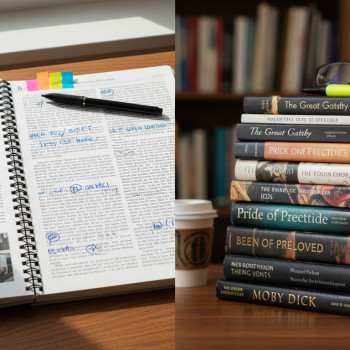Why Deep‑Work Days Matter for AP Students
When you’re preparing for AP exams, quantity of hours rarely beats quality. A three‑hour scrolling, half‑attentive cram session looks productive on paper but seldom moves the needle. Deep work—those extended, distraction‑free periods of intense, focused study—lets you learn faster, retain more, and build the higher‑order problem solving AP tests demand. This piece walks you through how to design solo deep‑work days that fit a busy high school life, with concrete schedules, examples, and a sample week you can start using right away.

The case for solo deep work
Solo deep work gives you two advantages that group study rarely matches: personalization and pace control. You can tailor the session to the topic you most need (e.g., AP Chemistry kinetics, AP US History period analysis, or AP Calculus BC integration techniques) and set the tempo based on your current energy. Done right, solo deep work builds conceptual fluency rather than surface familiarity—exactly what AP rubrics reward.
Principles to Build Your Deep‑Work Day
Before you draft a schedule, anchor your planning in principles that maximize cognitive performance and long‑term retention.
- Clarity of purpose: Each deep‑work block should have one explicit outcome (e.g., “Master all AP Chemistry equilibrium calculations for Sections 2 and 3,” not just “study equilibrium”).
- Chunking over marathoning: Focused 60–90 minute blocks beat vague, extended sessions when the goal is insight and complex problem solving.
- Active, not passive, review: Use practice questions, self‑explanations, and teaching‑to‑an‑imaginary‑peer rather than rereading notes.
- Recovery matters: Short recovery breaks and longer recovery activities (exercise, sleep, hobbies) consolidate learning and prevent burnout.
- Feedback loops: Test yourself under realistic conditions frequently and adjust study targets based on the results.
Science‑backed habits to pair with deep work
Your brain doesn’t operate in a vacuum. These habits reliably boost the effectiveness of focused sessions:
- Prioritize sleep—memory consolidation happens during slow‑wave and REM sleep.
- Stay hydrated and fuel with balanced meals; blood glucose affects attention span.
- Use the Pomodoro rhythm or 90‑minute ultradian cycles to align with natural energy waves.
- Limit notifications and create a dedicated study environment to reduce switch costs.
Designing a Deep‑Work Day: A Step‑by‑Step Framework
Below is a repeatable routine you can adapt. Think of it as a template, not a rulebook—adjust timings to fit your school day and energy patterns.
Step 1 — Define the Mission (10–15 minutes)
Start by writing a single, measurable mission for the day. This keeps you honest and helps prioritize when distractions appear.
- Bad mission: “Study AP History.”
- Good mission: “Score 90% or higher on today’s APUS Unit 6 practice set and write two short thesis statements comparing colonial economies.”
Step 2 — Warm‑Up (15–20 minutes)
Activate the relevant knowledge network with a quick review or mixed practice of foundational items you’ll need. This could be a 15‑minute spaced retrieval quiz, flashcard sprint, or a fast pass over a formula sheet.
Step 3 — Deep Block 1 (60–90 minutes)
Attack the hardest task first—often the topic you dread. Use fully focused practice: explain concepts aloud, work through synthesis‑level problems, and annotate mistakes immediately.
Step 4 — Recovery (20–40 minutes)
Move away from your desk. Do light exercise, hydrate, and eat a small snack. The goal is cognitive reset, not another screen session.
Step 5 — Deep Block 2 (60 minutes)
Shift to a complementary task: if Block 1 was heavy conceptual work, use Block 2 for application—timed practice sets, free response questions, or practice essays under exam constraints.
Step 6 — Review and Reflect (20–30 minutes)
Record the day’s wins and gaps in a study journal. Note down one strategy to adjust tomorrow and one concept that still feels shaky.
Sample Deep‑Work Day Schedules
Not every student has the same blocks available. Here are three sample schedules: one for school‑day evenings, one for long weekend study days, and one for compressed finals weeks.
| Schedule Type | Time Window | Structure | Best For |
|---|---|---|---|
| School‑Day Evening | 5:00 PM – 8:30 PM | Warm‑up 15m • Deep 60–75m • Break 30m • Deep 60m • Review 15m | Students balancing classes, activities, and family time |
| Weekend Deep‑Work Day | 9:00 AM – 4:00 PM | Mission 10m • Deep 90m • Break 30m • Deep 90m • Lunch 60m • Deep 60m • Review 20m | Stretch focus; tackle cumulative topics and practice exams |
| Compressed Finals Week | 7:30 AM – 7:00 PM | Two deep blocks (90m each) separated by active breaks, plus 3 practice test sections | High‑intensity review with frequent exam‑simulated practice |
How to choose topics for each block
Prioritize topics using a simple triage: High impact + low mastery first. Use your latest practice scores, AP Classroom progress checks, or a quick self‑quiz to identify low mastery areas that earn many points on the exam. For example:
- AP Biology: Focus first on cellular respiration and experimental design if these show repeated errors in practice FRQs.
- AP Language: Prioritize synthesizing evidence and thesis construction if timed essays lose points for weak claims.
- AP Calculus: Tackle application‑heavy integrals or differential equation problems you consistently misapply.
Active Practice Techniques That Turn Focus Into Scores
Deep work is only as good as the methods you use inside it. Switch passive review for active, retrieval‑oriented strategies.
Self‑explanation and interleaving
Talk through each step as you solve a problem and mix problem types within a block—interleaving forces discrimination between strategies and strengthens transfer to new question formats.
Progressive testing
Start with untimed conceptual probes, then move to timed sections, and finally full practice sections under simulated exam conditions. That progression builds accuracy, speed, and endurance.
Error mapping
Keep an error log: record the mistake, the root cause (knowledge gap, careless error, time pressure), and a corrective strategy. Over a week you’ll see patterns and can target them specifically.
Weekly Deep‑Work Plan: A Practical Template
Consistency beats sporadic marathon sessions. Below is a one‑week template you can personalize.
| Day | Primary Focus | Deep Blocks | End‑of‑Day Check |
|---|---|---|---|
| Monday | Foundations and quick wins | 2 blocks (60–75m each) | Short quiz, error log update |
| Tuesday | New content + worked examples | 1 long block (90m) + 1 short (45m) | Self‑explain one past FRQ |
| Wednesday | Application and timing | Timed practice sections | Grade and annotate |
| Thursday | Weakness focus | 2 focused blocks (60m) | Teach the topic to a peer or voice memo |
| Friday | Mixed practice + review | 1 block (75m) | Reflect and set next week’s mission |
| Saturday | Full practice exam or deep cumulative review | 3 blocks across the day | Detailed post‑test analysis |
| Sunday | Recovery and light review | Short, low‑intensity sessions | Rest, sleep, hobby |
Example: Converting a weak topic into mastery
Say you repeatedly lose points on AP Physics FRQs that require free‑body diagram reasoning. Your plan could be:
- Mission: Solve ten FRQs on Newton’s laws with perfect free‑body diagrams and annotated force labels.
- Warm‑up: 10 retrieval questions on basic vectors and Newton’s 2nd law.
- Deep Block 1: Work five sample FRQs, explain each step aloud, and redraw diagrams for variants.
- Deep Block 2: Timed mini‑quiz (2 FRQs) and rapid error mapping.
- Follow‑up: Teach the method in a 5‑minute voice note or to a study partner; this cements transfer.
Tools and Environment: Building Your Solo Deep‑Work Kit
You don’t need fancy gear—consistency and good tools matter more than aesthetics. Here’s a checklist to optimize your space and systems.
- Physical: Clean desk, reliable lamp, comfortable chair, water bottle, small snack.
- Digital: Disable nonessential notifications; use a site blocker for social media during deep blocks.
- Materials: Paper and pen for error logs, practice books or printer‑friendly past questions, calculator (where appropriate), formula sheets.
- Timers: Use a visible countdown timer to manage blocks and breaks; the simple act of seeing time left reduces anxiety.
Techniques to reduce distraction
Try a pre‑commitment device: put your phone in another room, or use a physical lockbox for devices during deep blocks. If digital notes are essential, open only the single tab or app you need.
When to Get External Help: Amplifying Solo Gains
Solo deep work is powerful but sometimes you will hit a persistent ceiling. That’s where targeted help speeds progress: expert tutors can identify blind spots you can’t see alone, suggest alternate problem‑solving frameworks, and run through exam strategies tailored to AP rubrics.
If you’re considering external support, look for offerings that complement solo work: 1‑on‑1 guidance to target misconceptions, tailored study plans that lock into your deep‑work schedule, and expert feedback on timed practice. Services that combine human tutors with AI‑driven insights can be especially efficient—AI highlights recurring error patterns and tutors translate that into clearer learning steps. Sparkl’s personalized tutoring offers these kinds of benefits, like tailored study plans, expert tutors, and AI‑driven insights that fit naturally with deep‑work days when you want precise, actionable feedback without losing control of your solo routine.
Measuring Progress: Metrics That Actually Help
Stop treating study time as the only success metric. Here are measurements that reflect true learning:
- Accuracy on mixed practice sections under timed conditions (aim for steady improvement, not perfection overnight).
- Reduction in the same error types appearing in the error log.
- Time to solution for representative problems—are you faster without sacrificing correctness?
- Quality of written responses: Are thesis statements clearer? Are explanations more concise and evidence‑based?
How to run a weekly progress audit
Every Sunday evening, spend 20 minutes reviewing your error log, practice scores, and subjective energy levels. Ask three questions:
- What improved this week and why?
- What repeated mistakes need a different strategy?
- What is one measurable goal for next week?
Common Pitfalls and How to Avoid Them
Knowing the traps lets you preempt them.
- Overplanning: A beautiful schedule is useless if it’s rigid. Keep buffer space for life’s unpredictability.
- Shallow multitasking: If you answer texts while “studying,” you’re dismantling deep‑work gains. Treat focus like a muscle—train it gradually.
- No review loop: Practicing without tracking errors leads to repetition of the same mistakes. Use an error log religiously.
- Ignoring energy cycles: Some students are sharpest in the morning; others at night. Align the hardest deep block with your peak energy.
Real‑World Example: One Student’s Deep‑Work Transformation
Alex, an AP Statistics student, used to cram the night before tests and scored inconsistently. Alex switched to weekly deep‑work days for three months: two focused blocks on hypothesis testing and one on probability every alternate weekend, plus nightly 15‑minute warm‑ups. Alex kept a small error log and used timed practice each Saturday. The result: consistent score increases on practice exams, a reduction in careless algebra errors, and newfound confidence when tackling multi‑part FRQs. The key change was shifting from quantity to high‑quality, deliberately varied practice.
Putting It All Together: A 6‑Week Deep‑Work Ramp
Use this progressive plan when you have six weeks before a big AP exam.
- Weeks 1–2: Build habits—2 deep days per week, focus on weak foundational topics and create an error log.
- Weeks 3–4: Intensify—3 deep days, add timed practice sections, and begin interleaving topics within blocks.
- Week 5: Simulate—at least one full practice exam under test conditions and focused remediation on missed concepts.
- Week 6: Taper—maintain light deep blocks for confidence and review formulas, timing, and exam logistics. Prioritize sleep and recovery in the final 72 hours.
Example weekly snapshot in Week 4 (Sample for AP Chemistry)
| Day | Deep Block 1 | Deep Block 2 | Outcome Target |
|---|---|---|---|
| Tuesday | Thermochemistry practice (90m) | Equilibrium FRQs timed (60m) | Reduce conceptual errors on Le Chatelier by 50% |
| Thursday | Stoichiometry mixed problems (75m) | Electrochemistry mini‑quiz (45m) | Increase speed on stoichiometry setups |
| Saturday | Full practice exam sections (3h with breaks) | Post‑test analysis (60m) | Identify three recurring error types |
Final Notes: Make It Yours
Designing effective deep‑work days is less about copying a schedule and more about understanding how you learn. Start with the small template here, measure honestly, and iterate. The power of solo deep work lies in its capacity to turn intentional practice into real, measurable gains on AP exams.

When you need sharper feedback or a plan that plugs directly into your deep‑work days, targeted 1‑on‑1 guidance can be a force multiplier. Personalized tutoring like Sparkl’s can provide tailored study plans, expert tutors who debug thinking errors, and AI‑driven insights to highlight patterns in your practice—so your deep‑work days stay focused and efficient. Use outside help strategically, and keep most of the heavy lifting in deliberate, solo practice.
Quick Checklist: Before Your Next Deep‑Work Day
- Mission written and measurable.
- Materials and timers ready; phone out of reach.
- Two deep blocks planned with complementary goals.
- Error log accessible and set to record mistakes.
- Recovery activity planned for between blocks.
Parting Thought
AP prep is a marathon of deliberate choices. When you design deep‑work days that respect how attention and memory actually function, you convert hours into expertise. Start small, track honestly, and iterate. Your next deep‑work day could be the turning point—not because you studied harder, but because you studied smarter.
Ready to design your first deep‑work day? Pick one mission from this article and commit to it tomorrow—set the timer, minimize distractions, and test whether concentrated focus changes your results. It will.



















No Comments
Leave a comment Cancel